Physical Address
304 North Cardinal St.
Dorchester Center, MA 02124
Linear skull fractures require no stabilization or exploration when the scalp is closed and when there is no evidence of an underlying mass lesion. Management of comminuted fractures is the same as for linear skull fractures if the skin is closed and no depression of bone fragments is seen on computed tomography. Closed depressed skull fractures with a greater than 1-cm depression, or a full-thickness width of the nearby calvarium, require operative repair. In cases where obvious dural laceration or involvement of the frontal sinus raises concern for infection or CSF leak, operative exploration may be required. Open depressed skull fractures require urgent operative intervention.
Growing skull fractures (GSFs) are most commonly seen in children younger than 3 years of age and have been estimated to involve between 0.05% and 1.6% of pediatric skull fractures. If there is a tear in the dura, the brain pulsations in a growing brain may enlarge the dural opening and skull fracture. In a confirmed case of GSF, surgical repair includes craniotomy surrounding the GSF, followed by dural closure and cranioplasty.
Fractures at the base of the skull carry risks of cranial nerve damage, CSF leak, and vascular injury, as well as extension of injury to the orbit, auditory apparatus, and facial bones. Therefore they often require interdisciplinary management by neurosurgeons, craniofacial plastic or oral/maxillofacial surgeons, otolaryngologists, and ophthalmologists.
With combined injuries of the cranium and face, repair of the skull base, frontal sinus, and dura should be synchronous with the facial fracture repair to prevent disruption of the dural and skull base repair with manipulation of the facial bones.
In repair of naso-orbital ethmoid injuries, care needs to be taken to leave the medial canthal ligament attached to the central segment of displaced medial orbital rim. Repositioning and anatomic repositioning of this segment will correct the telecanthus without needing to reposition the medial canthal tendon.
When reconstructing an orbital blowout injury with an implant or bone, care must be taken to reproduce the normal anatomic bulges of the orbit to restore normal orbital volume.
Skull fractures are classified in three ways: by pattern (linear, comminuted, depressed), by anatomic location (vault convexity, skull base), and by skin integrity (open, closed). Fractures with high-impact force may be complex in configuration and may span both the skull convexity and base. Open (or compound ) skull fractures are those that communicate with the extracranial space, either by laceration of skin/soft tissues or by fracture through the paranasal sinuses and middle ear structures.
In modern emergency care, computed tomography (CT) of the head is obtained when a patient presents with head injury along with confusion, vomiting, loss of consciousness, focal neurologic deficit, or concerning mechanism (eg, automobile vs pedestrian, fall from height, altered mental status preceding a fall). Evidence of open skull fracture or skull base fracture (eg, periorbital ecchymoses, mastoid ecchymosis, cerebrospinal fluid rhinorrhea/otorrhea) is an additional indication for imaging. Among patients diagnosed with skull fracture, the incidence of intracranial contusion or hematoma is almost double, compared to those with head trauma and no skull fracture observed on CT.
The pattern of a skull fracture is affected by the force of impact, as well as the ratio of impact force to the impact area. If the impact is dispersed over a large enough area (eg, in helmeted head injury), skull fracture may be avoided entirely. Impact concentrated over a small area (eg, hammer blow) can produce localized severe trauma to the calvarium. A linear skull fracture represents a single fracture line that travels through the entire thickness of the skull, occurring when the skull fails to undergo further elastic deformation as a response to impact. The fracture typically starts at the point of weakness in response to the maximal stress, which may be remote from the actual impact point. The fracture then extends to the point of initial impact. A comminuted fracture results when the impact force is sufficient to break the bone into multiple pieces under the point of impact and further through areas of weakness. Comminution absorbs the force of the injury, and multiple linear fractures radiate from the point of impact. Fracture lines may extend through and separate the cranial sutures, a process called suture diastasis .
Linear skull fractures require no stabilization or exploration when the scalp is closed and when there is no evidence of underlying mass lesion (eg, hematoma, compressive contusion) or dural injury. Even when a scalp laceration is present, seldom is surgical exploration with bone removal necessary. Exceptions would include a machete injury to the skull producing a linear skull fracture with underlying dural laceration. The skull fracture does indicate that significant head trauma has occurred, and a careful assessment of the brain, facial structures, and cervical spine is required. Open linear fractures are debrided of foreign material, devitalized soft tissue, and bone fragments; the damaged soft tissue at the edges of the laceration is excised to bleeding tissue, and the laceration is closed after thorough cleansing. If there is insufficient vascularized soft tissue present to permit excision of the contused devitalized tissue, a rotational flap and skin graft to the donor area may be necessary.
If the skin is closed and no depression of bone fragments is seen on CT, management of comminuted fractures is the same as for linear skull fractures. However, in many of these cases, surgery is performed for the underlying intracranial pathology. Fig. 28.1 demonstrates a skull fracture caused by impact to the lateral forehead. A comminuted fracture fragment is located anteriorly. A linear portion of the fracture, seen best in the coronal plane ( Fig. 28.1B ), extends from the coronal suture to the lambdoid suture. This fracture line crosses the path of the middle meningeal artery and is associated with an underlying epidural hematoma requiring surgical removal ( Fig. 28.1C ). After the hematoma was evacuated, bone fragments were plated and replaced.
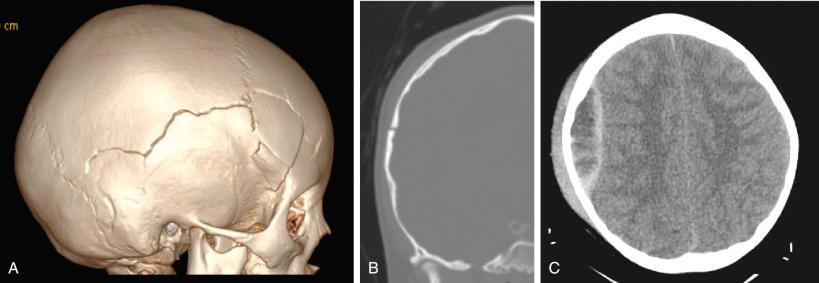
Skull fractures with fragmented bone can present with the bone pressing on dura or penetrating the dura/brain. Bone may either be subluxed at the interface of fracture and intact skull or alternatively near the center of the fracture by wedging inward of displaced fragments. A double density appearance on skull radiographs can suggest a depressed fracture, although determining the full extent and depth of injury requires a CT scan. The information gained by inspection of standard axial CT bone windows can be augmented with digital multiplanar views, as well as a three-dimensional (3D) reconstruction. In Fig. 28.2 , a bilateral comminuted fracture spans a large area of the skull convexity, with axial views revealing diastasis of the coronal and sagittal sutures ( Fig. 28.2A ). The 3D and coronal reconstructed views allow better appreciation of the fragments themselves, and this perspective can be helpful when planning soft tissue dissection over areas of dislodged bone and also useful if locating depressed fragments concealed/subluxed beneath the fracture edge ( Fig. 28.2B–C ). The primary indication for surgery in this example was a large subdural hematoma. The fracture required extensive plating and calvarial reconstruction ( Fig. 28.2D–E ).

In closed depressed skull fractures that do not possess admixed features themselves requiring surgery (eg, mass effect, underlying hematoma), the primary question regarding operative management is one of cosmesis. Factors to consider include (1) the extent of depression and (2) the location of the fracture, which will affect the cranial appearance. A greater than 1-cm depression, or a full-thickness width of the nearby calvarium, is often cited as a threshold for operative repair. Although 1 cm is a reasonable metric, it should be viewed through the final lens of patient opinion and cranial aesthetics. Although a focal neurologic deficit from the cortical injury directly under a depressed skull fracture is occasionally improved by elevation of the bone fragments (presumably by increasing local cortical blood flow), elevation usually produces no neurologic change, implying that impact itself yields the major cortical damage responsible for a brain deficit, rather than continued pressure from depressed fragments. Such brain dysfunction usually undergoes a neurologic recovery phase of several weeks to months, similar to that after a stroke or a head injury without a depressed fracture. Likewise, the incidence of epilepsy after a depressed skull fracture is determined by the cortical damage at the time of impact. The treatment of depressed skull fracture is based less on initiating neurologic recovery or preventing epilepsy. Fracture elevation is more commonly performed on a semielective basis in the first few days after the trauma, once the patient is cleared for anesthesia. In cases where obvious dural laceration or involvement of the frontal sinus raises concern for infection or a cerebrospinal fluid (CSF) leak, operative exploration may be required for this separate indication. Frontal sinus fracture will be discussed later in this chapter.
Restricted cranial venous outflow may occur if a depressed fracture fragment is located overlying a major dural sinus. Given the potential for profuse bleeding from a sinus laceration that is exposed intraoperatively, the decision to operate on a depressed fracture overlying a venous sinus is made with additional focus on intraoperative risk. The degree of sinus stenosis can be identified through noninvasive studies; most commonly a CT venogram is obtained on presentation when sinus involvement is of concern. Although the presence of sinus underlying a fracture can arguably be used to support conservative management rather than immediate intervention (due to risk of intraoperative hemorrhage), the complete or near-complete occlusion of a sinus has the potential to yield cortical venous hypertension, elevated intracranial pressure (ICP), and venous stroke; the avoidance of these sequelae may justify operation to alleviate pressure on the sinus.
Sinus occlusion can occur due to direct pressure on the sinus or from an intravascular thrombus. Fig. 28.3A–B shows a closed depressed skull fracture overlying the mid-to-posterior third of the sagittal sinus, resulting in sinus stenosis. In this case, frequent increases of ICP were attributable to venous hypertension, and the fracture was elevated and repaired in the operating room with no sinus laceration observed. Postoperatively, ICPs improved, and a follow-up venogram showed restored patency of the sagittal sinus. Fig. 28.4 demonstrates that sinus thrombosis can occur in the absence of depressed fracture fragments. A right-sided linear nondepressed occipital fracture with diastasis of the lambdoid suture ( Fig. 28.4A ) and occipitomastoid suture ( Fig. 28.4B ) was associated with complete right transverse sinus thrombosis. The patient was managed medically with intravenous heparin and transitioned to Coumadin for 3 months with follow-up venous phase vascular imaging demonstrating lack of clot propagation as well as gradual sinus recanalization. When considering systemic anticoagulation for cerebral venous sinus thrombosis, attention must be given to the presence of existing intracranial hemorrhage. No randomized study has been performed regarding the duration of long-term anticoagulation for traumatic cerebral venous sinus thrombosis, and the existing practice parameters for systemic venous thromboembolism have therefore been used as a surrogate.

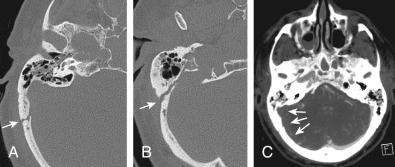
Fractures with dural sinus involvement occur most commonly in the anterior and middle portions of the sagittal sinus. The operative management of sinus injury involves the careful elevation of bone, followed by mechanical tamponade of bleeding using autologous tissue such as a muscle plug or pericranium, cottonoids, or Gelfoam. If mechanical pressure does not succeed in timely cessation of bleeding, primary sinus repair or an autologous dural patch may be performed. Alternatively, a dural flap may be fashioned, with an intact pedicle adjacent to the lacerated area, and folded over the region of injury. Dura may be tented up to bone to tamponade sinus bleeding when adjacent bone is present, with care taken to avoid stenosis of the sinus by this maneuver. Location of an injury within the anterior third of the sagittal sinus may permit sinus ligation with a reduced risk of venous stroke, although inspection of the venous cortical drainage into the sinus provides additional patient-specific information regarding potential for stroke. Complete sinus reconstruction may also be performed, using autologous dura, harvested vein, or synthetic material.
By definition, an open or compound skull fracture is one with contiguous disruption of the soft tissues and galea, placing intracranial contents in potential contact with the external environment. It is most common for depressed skull fractures to be open rather than closed, and the consequent possibility for infection influences the goals of management. It is common practice for patients with open depressed skull fracture to be given broad-spectrum antibiotics, although the question has not been studied through systematic means. The type and duration of antibiotics are chosen based on local standards of practice. Historically, neurosurgical recommendations have included urgent operative intervention for all open depressed skull fractures. Jenett and Miller in the 1970s published a retrospective series with an infection rate of 36.5% in cases where open depressed skull fractures were delayed >48 hours prior to operative washout and debridement. With timely surgical intervention, the infection rate dropped to 4.6%. The lower rate of infection correlated with lower rates of all complications, epilepsy, neurologic deficit, and overall mortality.
More recent recommendations distinguish those open depressed skull fractures that lack (1) depression greater than 1 cm or involvement of the frontal sinuses, (2) evidence of dural penetration or significant intracranial hematoma, (3) cosmetic deformity, and (4) gross contamination or existing infection. Among the fractures that do not have any of these listed features, nonoperative management with thorough bedside washout and closure yielded good results with low/negligible infectious complications. Fractures that do not meet all these criteria should receive early operative debridement and repair, with operative goals including closure of the dura, removal of foreign material, debridement of devitalized scalp, and calvarial reconstruction ( Fig. 28.5 ).
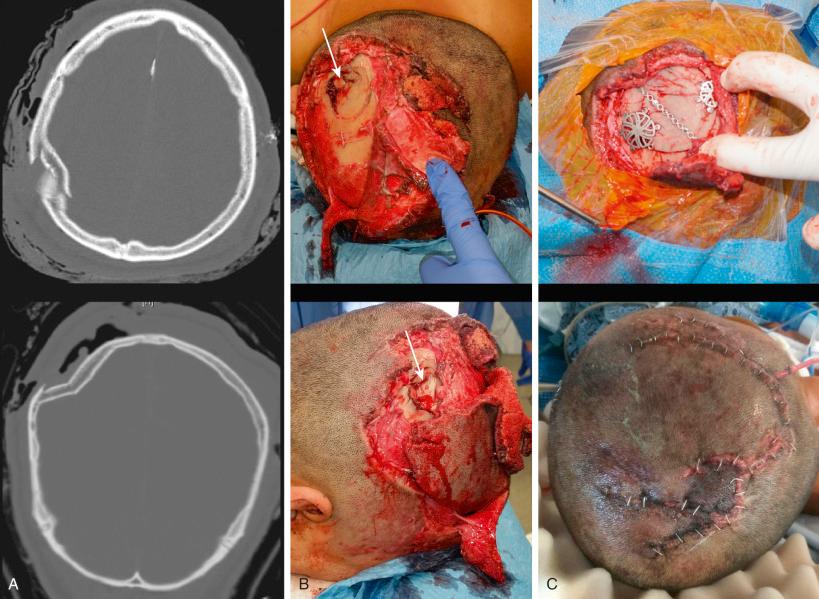
The presence of a stellate scalp laceration with devitalized tissue may require extensive tissue debridement, flap coverage, staged debridement of bone or soft tissue, and possible delayed cranioplasty. Reconstruction of the calvarium is performed during the initial surgery if considered safe. Multiple observational studies have demonstrated the safety of plating and replacing bone fragments at the time of initial repair, without additional infectious risk. The major reasons to consider deferred calvarial reconstruction are to shorten additional anesthesia and blood loss in an unstable polytrauma patient or due to contamination of the bone fragments that cannot be adequately cleaned.
The morphology of both sutures and calvarial bones gradually change as children age. The elastic modulus and density of cranial bone increase, allowing greater impact to be tolerated without fracture. Cranial bone in infants exists as a single cortical layer and immediately begins a transformation to the cortical−cancellous−cortical structure of mature calvarium within the first 6 months of life. The characteristic diploë of adult bone is present by approximately age 4 years. Compared to the size of an adult skull, the growing calvarium is approximately 25% of adult size at birth, 75% at age 2 years, and 95% at age 10 years. Suture lines accumulate additional type 1 collagen and progressively ossify to form an interleaved fibro-osseous structure that is more resistant to tensile stress yet allows mild mechanical deformation to resist injury from impact.
From 2% to 20% of presenting head injuries in the pediatric population have been associated with a diagnosis of skull fracture, although most of these do not require operative intervention. Among diagnosed pediatric skull fractures, 60% to 90% are linear and nondepressed, and the majority of fractures occur to the parietal bone. Although >90% of linear fractures demonstrate palpable extracranial swelling, only 15% to 30% have associated intracranial contusion or hematoma. The most common mechanisms for pediatric skull fracture include falls, collision of objects to the head, and motor vehicle collision. An evaluation for nonaccidental trauma should be considered when fractures are found in multiple cranial bones, occur in the absence of an accurate history, or are accompanied by other systemic injuries (eg, extremity fractures at various stages of healing, retinal hemorrhages, burns). An estimated 10% of all traumatic injuries to children younger than 5 years of age are nonaccidental in nature.
Due to the thin and highly deformable bony structure early in life, impact to the young skull can manifest as a greenstick fracture. Flexible bone breaks incompletely and generates a fracture classically compared to a thumbprint indentation on a ping-pong ball ( Fig. 28.6 ). These so-called ping-pong fractures are caused by abdominal trauma in utero, injury during birth (eg, from obstetric instruments), and impact injury early in life (0–3 years). Conservative management of these fractures has been successful and is typically elected if the extent of depression does not exceed 5 mm. For ping-pong fractures with significant depression, a number of strategies have been successful, ranging from burr hole placement with direct elevation of the fracture, to externally applied suction for noninvasive elevation.
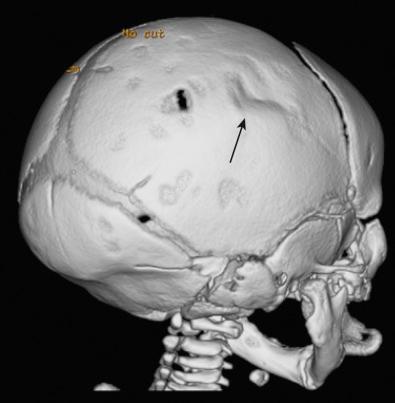
The first case of growing skull fracture (GSF) was reported by British surgeon Dr. John Howship in the 1800s. The phenomenon has since acquired many names, including posttraumatic cephalhydrocele, leptomeningeal cyst, meningocele spuria, and craniocerebral erosion. GSF begins with a skull defect generated by trauma. The defect expands over time due to the presence of intracranial contents (ie, leptomeninges and brain) that occupy the fracture line and interfere with bony healing. These fractures are most commonly seen in children younger than 3 years of age and have been estimated to involve between 0.05% and 1.6% of pediatric skull fractures. The median time between initial injury and presentation for GSF is 18 months. Fig. 28.7A shows a traumatic skull fracture with underlying brain injury. On 9-month follow-up, a large bony fissure was found, spanning the occipital, parietal, and frontal bones, as seen on 3D CT reconstruction ( Fig. 28.7B ). T2-weighted MRI demonstrates interposed CSF collection with herniated leptomeninges, characteristic of the GSF phenomenon ( Fig. 28.7C ). Torn dura is a requisite condition for GSF, and a greater degree of fracture diastasis (>4 mm) makes GSF increasingly likely. Cortical irritation and reactive gliosis can result from the interaction between pulsatile brain and the fracture edge, occasionally leading to the formation of porencephaly and the development of seizure or focal neurologic deficit. The mechanism for nonhealing of the GSF may be biochemical, as from absence of secreted dural growth factors over a region of dural laceration, or physical, from hindered apposition of fracture edges due to focally herniated leptomeninges and slow pulsatile erosion from intracranial contents. The presence of undiagnosed hydrocephalus may compound the erosive force of pulsatile brain/leptomeninges.

In fractures where potential development of GSF is a significant concern, close follow-up can be used to monitor for palpable calvarial defect. Contrast-enhanced MRI may also be obtained at the time of injury, in cases of high clinical suspicion, to demonstrate the presence of a dural laceration and thus guide immediate treatment or close follow-up. In a confirmed case of GSF, surgical repair includes craniotomy surrounding the GSF, followed by dural closure (pericranial or synthetic dural patch), and split-thickness autologous cranioplasty versus synthetic or mesh cranioplasty depending on size of the calvarial defect. In cranial repair, it is of utmost importance to achieve complete dural closure and good approximation of grafted bony edges. In cases where hydrocephalus is a compounding factor, shunt placement is appropriate prior to dural/calvarial repair. Improvement in GSF-associated seizure and focal deficits has been well documented after surgical repair.
Fractures at the base of the skull carry a combined risk of cranial nerve damage, CSF leak, and vascular injury, as well as extension of injury to the orbit, auditory apparatus, and facial bones. Skull base fractures therefore often require interdisciplinary management by neurosurgeons, craniofacial plastic or oral/maxillofacial surgeons, otolaryngologists, and ophthalmologists. Fractures of the anterior skull base can extend into the cribriform plate, frontal sinuses, and ethmoids, with the risk of anosmia as well as intracranial mucocele formation. These fractures may also include the orbital and sphenoid bone, with consequences including traumatic optic neuropathy and retro-orbital hematoma. Dural tears in this area may manifest as clear rhinorrhea, with passage of CSF through the frontonasal duct ( Fig. 28.8 ). Fractures to the middle skull base pose risks to the neurovascular structures of the petrous temporal bone and sphenoid, including the seventh and eighth cranial nerves, the carotid artery, the cochlea, the vestibular labyrinth, ossicles, and the nearby dural sinuses. An intracavernous arterial injury can result in carotid-cavernous fistula. A dural tear adjacent to a temporal bone fracture may produce CSF otorrhea if the tympanic membrane or external auditory canal is simultaneously lacerated (see Fig. 28.8 ). A dural tear can also present as CSF rhinorrhea, as CSF travels to the nasal cavity through the eustachian tube. Fractures to the bone of the occipital clivus and posterolateral basal occiput can present with lower cranial nerve palsy, yielding diminished gag reflex, dysphagia, vocal cord paralysis, or ipsilateral tongue deviation. Such fractures may also involve the occipital condyle and raise concern for craniocervical instability.
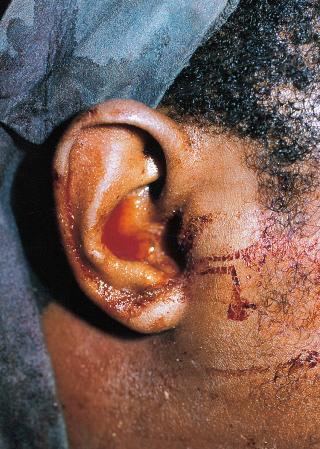
The rate of skull base fracture is approximately 4% among patients with severe head injury. Given the wide range of pathology that may accompany basilar skull fracture, a detailed clinical exam should include including full assessment of cranial nerve function. A detailed neuro-otologic exam (eg, for vertigo, nystagmus, hemotympanum, conductive/sensorineural hearing loss) and ophthalmologic exam should be performed in cases where middle or anterior fossa injuries, respectively, are suspected. External signs of basal skull fractures include bilateral periorbital ecchymoses (spectacle hematoma) ( Fig. 28.9 ), as well as ecchymosis over the mastoids (Battle sign).
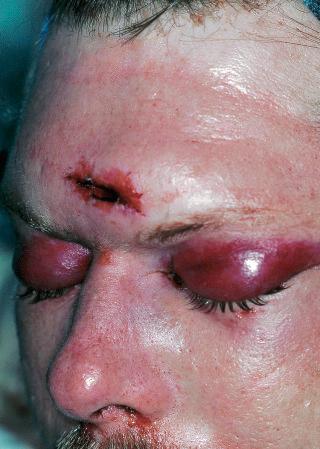
CSF leak occurs in ~15% of basilar skull fractures, with 150,000 cases per year in the United States. A dural tear can place the subarachnoid space in continuity with the paranasal sinuses or middle ear structures and provide a pathway for infection. A persistent fistula allows bacterial colonization of the meninges to eventually develop. CSF leak is most commonly observed within the first 2 days after trauma (80% of CSF leak cases ), although clinical vigilance for later presentations is advised. Bloody nasal discharge is commonly observed after facial fractures and may obscure the presence of CSF leak until days to weeks after the initial injury. Delayed presentation of CSF leak may occur due to the interval development of hydrocephalus after traumatic subarachnoid hemorrhage. Clot surrounding a skull base fracture may initially tamponade CSF leak from a dural laceration, but it can later break down, causing a new onset of CSF leak.
If persistent fluid drainage occurs after a fracture, the fluid may be evaluated to test for the presence of CSF. The most rudimentary test is for a so-called double ring sign ( Fig. 28.10 ). By the same principles as those applied in planar chromatography, the drainage of bloody discharge onto the patient's pillow or a paper towel can be seen to form a larger clear ring surrounding a central blood-tinged clot. Although this sign is often cited as support for CSF leak, many serosanguineous biologic fluid mixtures (eg, thin nasal mucus mixed with blood) can yield a similar appearance, and thus additional confirmatory testing is warranted. If fluid can be collected into a vial, laboratory testing for the presence of glucose helps to support the diagnosis of CSF leak. Glucose >30 mg/dL can be consistent with CSF presence, although blood/plasma in the fluid will also contribute to elevated glucose values. The most reliable laboratory test is for β-2-transferrin, using gel electrophoresis to detect a desialylated transferrin isoform found only in CSF and perilymph. Note that using β-2-transferrin, a perilymphatic fluid leak may be confused for a CSF leak. One of the most reliable tests for CSF fistula is by exam maneuver; an intermittent CSF leak from the paranasal sinuses can often be demonstrated by having the patient sit on the edge of the bed with the head close to the knees for 2 minutes, watching for clear fluid to drip from the nose.
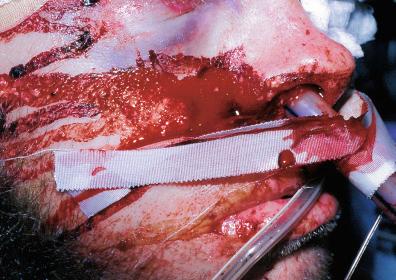
Because antibiotics are not effective in preventing meningitis and may select for resistant organisms if an infection occurs, prophylactic antibiotics are not used on a prolonged basis in patients with basal skull fractures and remain a topic of controversy. Many institutions use prophylactic antibiotics on a limited basis in the setting of skull base fracture with CSF leak, although it is widely held that leak persisting beyond 5 to 7 days is an indication for operative repair rather than expectant management.
Otorrhea is more likely than rhinorrhea to resolve spontaneously. Bloody/mixed fluid drainage from the external ear canal may also be caused by a temporomandibular joint injury or dislocation. Often, the placement of loose-fitting sterile gauze pads over the ear, changed every nursing shift, can indicate if the fluid drainage has slowed or stopped. A confirmed CSF leak is managed initially by observing the amount of drainage and monitoring for signs of infection (ie, elevated temperature, mental status, white blood cell count). Raising the head of bed to 30 degrees is a conservative maneuver that can decrease or stop the leak, both by the reduction in ICP and by the mechanical force of gravity on the frontal or temporal dura to internally tamponade the leak. If the leak persists beyond 2 to 3 days, sequential lumbar taps may be performed to remove 30 to 50 cc of spinal fluid. Alternatively, a lumbar drain may be inserted, with initial drainage of 10 to 15 cc/hr. Drainage may be increased to 15 to 20 cc/hour if the leak continues. Should pneumocephalus develop during the course of CSF drainage, the drainage procedure is terminated and the leak is surgically repaired. CSF leaks refractory to spinal fluid drainage require surgical closure; the exact site of the leak should be determined preoperatively. For imaging evaluation of a CSF leak, a CT cisternogram can be performed using a nonionic iodinated contrast agent (eg, iohexol [omnipaque], iopamidol [isovue], metrizamide). A radionuclide scan may also be used (eg, In-111-DTPA, Tc99m-DTPA). Planar imaging of the radiotracer is possible if the leak rate is high, with scans acquired at multiple time points postinfusion. Collection of radiotracer on nasal pledgets that are read in a well counter can detect more minute quantities of CSF.
Fractures through the petrous portion of the temporal bone may cause injury to the ossicles, cochlea, vestibule, semicircular canals, the external auditory canal (EAC), the facial and vestibulocochlear nerves, and the petrous segment of the internal carotid artery. As a consequence, a full evaluation should rule out hearing loss, disequilibrium, nystagmus, tinnitus, and facial weakness and should include the otolaryngology team as well as neurosurgery. The fracture pattern through the petrous temporal bone is often predictive of the injury that results. A longitudinal fracture that travels along the long axis of the petrous pyramid poses particular risk to the ossicles and is therefore associated with conductive hearing loss. The fracture itself often extends from the squamous portion of the temporal bone to the petrous apex, traveling along the EAC. This pattern can disrupt the tympanic membrane and cause otorrhagia or provide a portal for CSF otorrhea. The fracture can intersect the postgeniculate horizontal (tympanic) portion of the facial nerve and cause facial weakness by injury in this region. Transverse fractures cross the petrous temporal bone orthogonal to the long axis, with the fracture line extending from the foramen magnum to the middle fossa. Because the fracture line is likely to cross the internal auditory canal, sensorineural hearing loss from cranial nerve VIII injury and facial weakness from injury to the meatal and labyrinthine segments of the facial nerve should be considered. These fractures also pose a great risk to the bony labyrinth.
The majority of petrous temporal fractures are oblique/mixed in their orientation, and the number of true longitudinal fractures exceeds the number of true transverse fractures by a ratio of 4 : 1. The external force required to generate a transverse fracture is greater than that for a longitudinal fracture, and transverse fractures occur from impact to the occiput. Longitudinal fractures occur by impact to the lateral aspect of the squamous or petrous temporal bone.
Facial injuries often accompany injuries to the cranium due to the high velocity of the accidents associated with these injuries. As trauma critical care and neurologic surgery continue to improve, the number of patients surviving profound injuries increases and the need for coordinated efforts of the neurosurgical and plastic surgeons increases. For instance, fractures of the frontal bone or basilar skull commonly extend into the orbit, and midface fractures frequently accompany frontal skull, frontal sinus, or orbital fractures. In addition, fractures through the skull into the nasal sinuses can cause dural lacerations with CSF leak or pneumocephalus.
Initial assessment of any trauma patient should begin with a systematic evaluation as described in the Advanced Trauma Life Support (ATLS) algorithm. Emergency treatment is immediately directed toward life-threatening events such as (1) airway compromise due to obstruction or neurologic status, (2) breathing and ventilation, and (3) circulation (major hemorrhage can occur from the scalp or face). The stability of the cervical spine is assessed in every patient with head trauma during this phase.
Once stabilized, the events of the injury should be ascertained including speed, direction of impact, and loss of consciousness as described by the emergency medical team, patient, or family members. If possible, subjective visual disturbances, malocclusion, numbness, and a preinjury picture or description of the patient's appearance are helpful in predicting fracture patterns.
A thorough facial physical examination is performed in sequence, concentrating on functional deficits in areas of injury. Cranial nerves should be examined and documented; nerve deficits are another clue to underlying fracture patterns.
Soft tissue injury implies the possibility of damage to deeper structures, which should be presumed until appropriate examination excludes them. Hematomas are usually diffuse and not amenable to aspiration, but localized hematomas can be aspirated or removed to facilitate healing. Lacerations should be carefully irrigated with at least 3 L of saline, explored, and carefully debrided and reapproximated after damage to underlying structures has been determined.
The facial bones should be examined in a methodical sequence from top to bottom. Symptoms that imply bone injury include soft tissue injury (contusion, laceration, hematoma), bone movement, crepitation, localized tenderness, discomfort, numbness in the distribution of a cranial sensory nerve, paralysis in the distribution of a cranial motor nerve, malocclusion, visual acuity disturbance, diplopia, facial deformity or asymmetry, intraoral lacerations, fractured or avulsed teeth, air in soft tissues, and bleeding from the nose or mouth. The examiner should palpate the symmetry of the facial bones, comparing both sides. In all cases, references to old photographs (such as a driver's license) are valuable aids in documenting a preexisting facial deformity or in establishing a change from previous appearance. Dental malalignment (malocclusion) is an index of bone or tooth fracture, edema, or temporomandibular joint injury.
Facial sensation should be noted in the supraorbital, supratrochlear, infratrochlear, infraorbital, and mental nerve distributions. Diminished sensation in the distribution of a specific sensory nerve indicates injury from transaction, impact, or continued compression of the nerve as the result of a fracture. The facial nerve is tested by comparing facial expression bilaterally. Extraocular movements and pupil response are compared, evaluating symmetry, pupil size, and the speed of pupil reaction bilaterally to both direct and consensual responses to light.
Become a Clinical Tree membership for Full access and enjoy Unlimited articles
If you are a member. Log in here